Abstract
1. Injection of 20 μg of aconitine into the lateral ventricle of dogs anaesthetized with pentobarbitone regularly induced cardiac irregularities and hypertension. The cardiovascular changes appeared within 5 min and lasted for about 90 min. Tachyphylaxis to the aconitine-induced cardiovascular effects was observed.
2. The aconitine-induced arrhythmia and hypertension were centrogenic, for they were abolished or prevented by spinal transection (C2) or ganglionic blockade.
3. Bilateral vagotomy as well as bilateral stellate ganglionectomy merely raised the threshold for arrhythmia without affecting the blood pressure response. The neural supply to the heart, therefore, does not seem to be the major pathway concerned in the genesis of the centrogenic cardiovascular effects of aconitine.
4. The centrally evoked release of endogenous catecholamines from the adrenal glands was responsible for the aconitine-induced arrhythmia, since the arrhythmia could be blocked or prevented by prior reserpinization, bilateral adrenalectomy or thoracic splanchnic nerve section.
5. α- and β-adrenoceptive receptor blocking agents prevented or abolished the aconitine-induced arrhythmia in a manner similar to the catecholamine-induced arrhythmia.
Full text
PDF





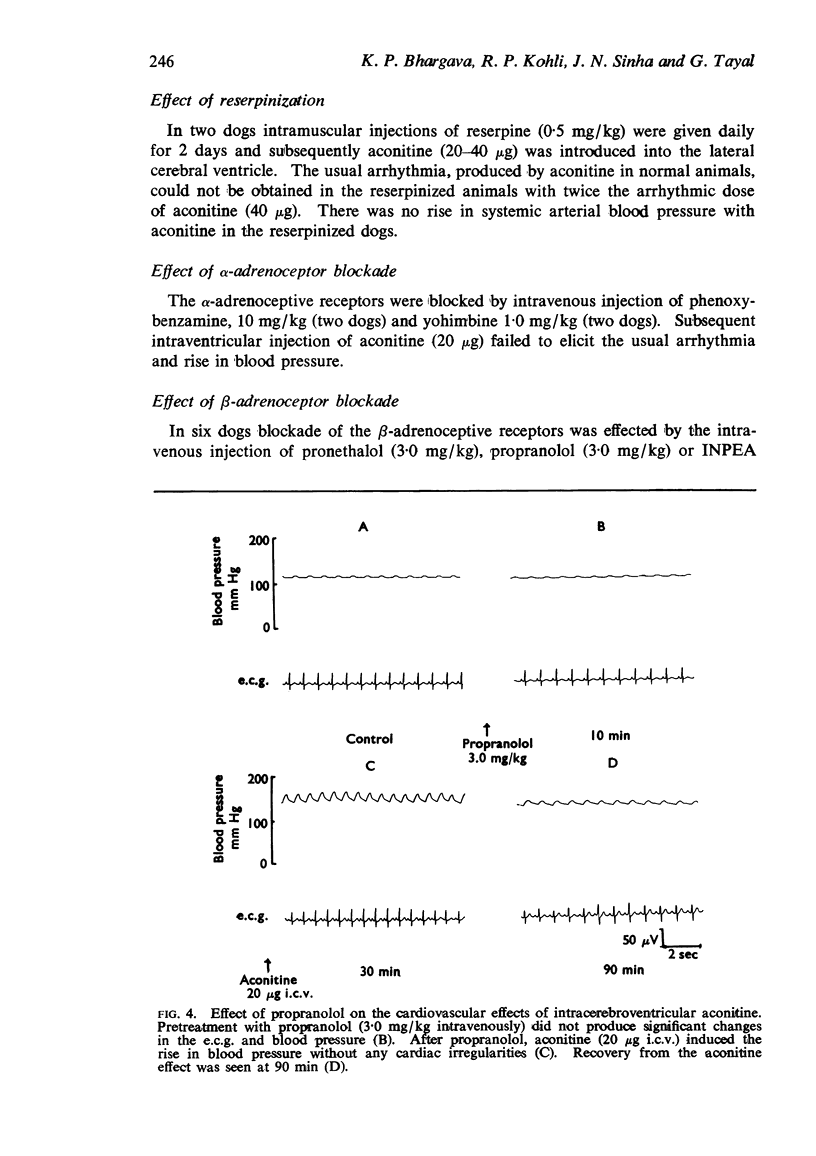
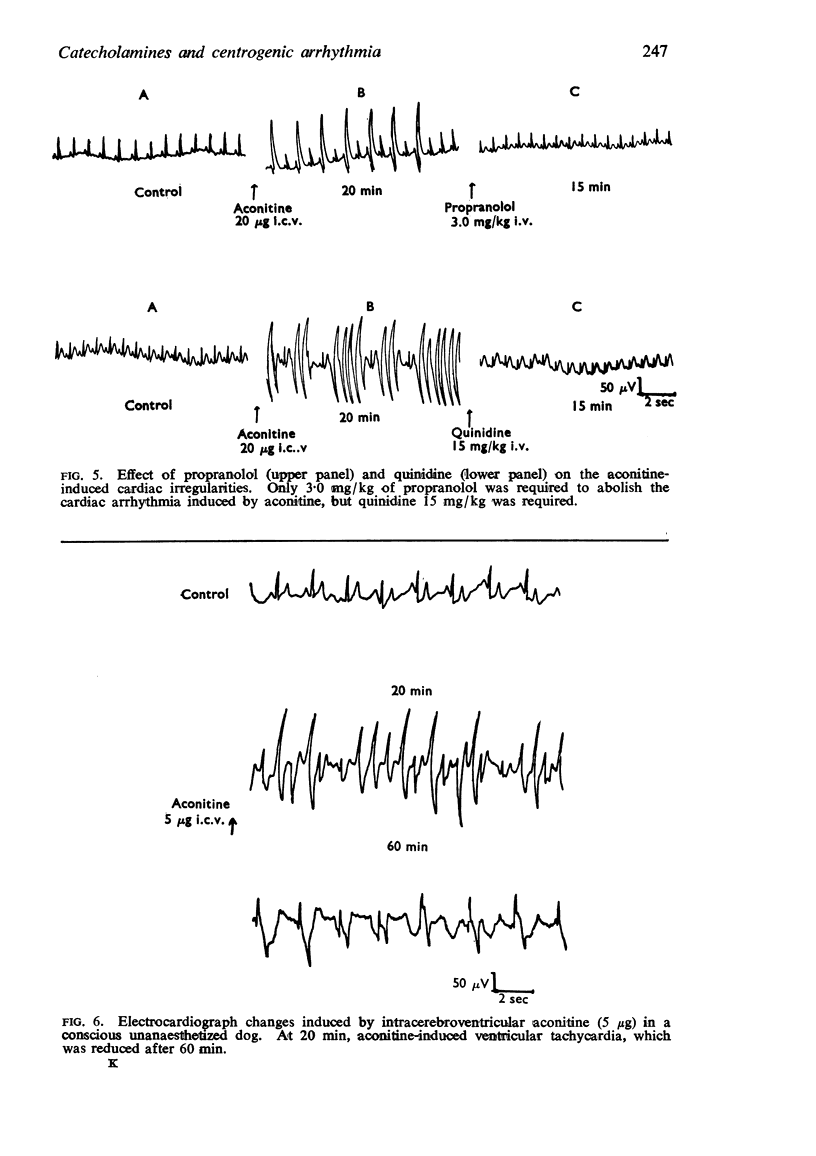
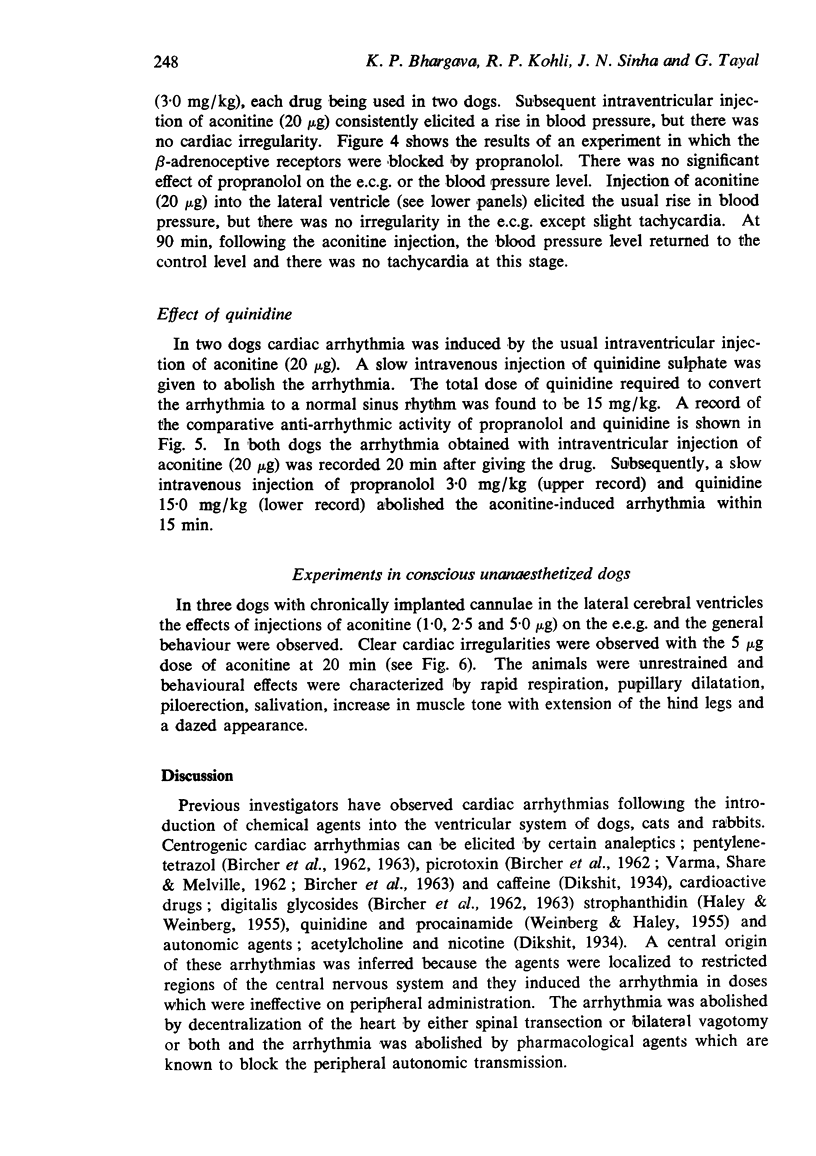


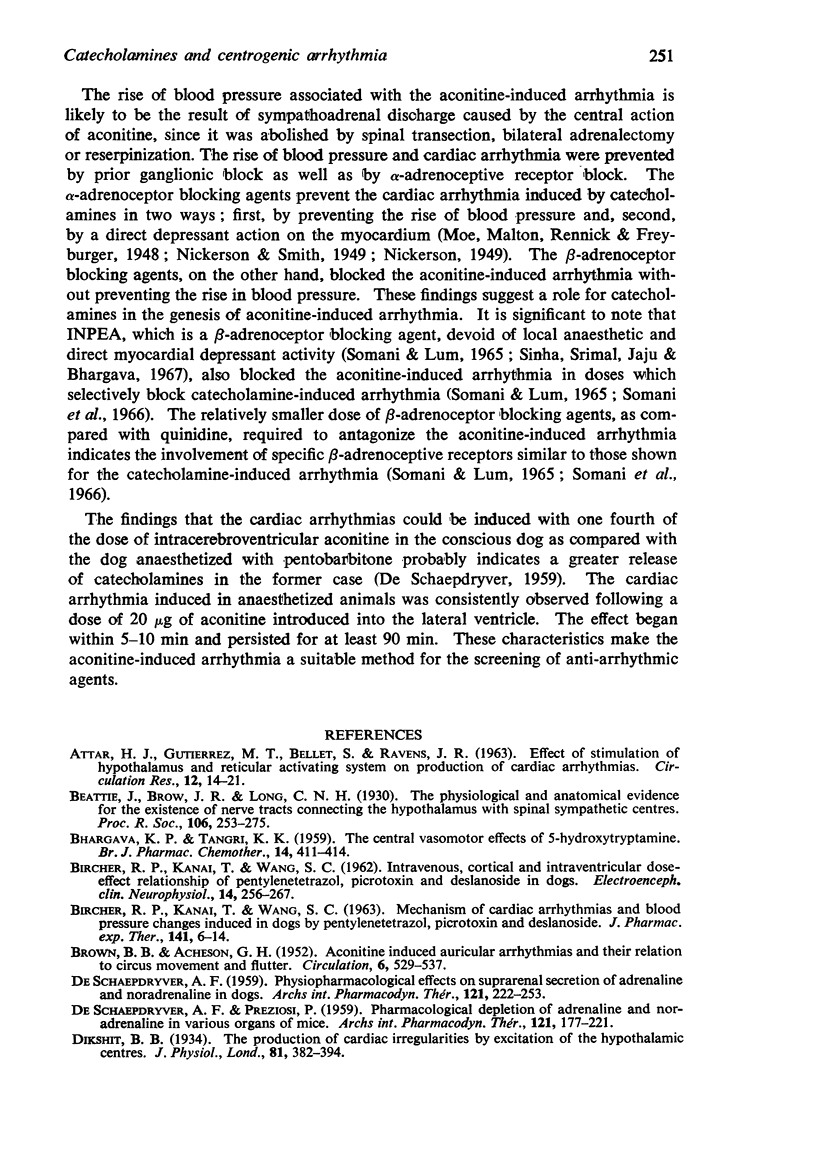
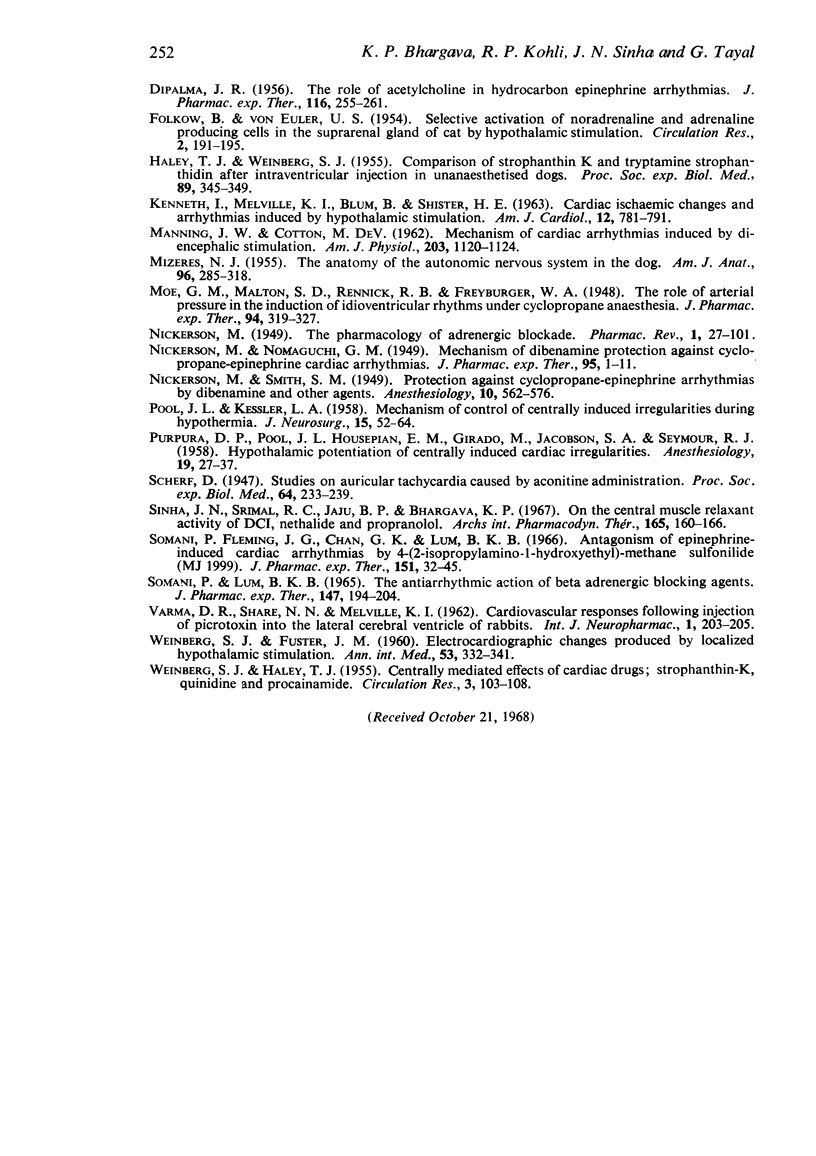
Selected References
These references are in PubMed. This may not be the complete list of references from this article.
- ATTAR H. J., GUTIERREZ M. T., BELLET S., RAVENS J. R. Effect of stimulation of hypothalamus and reticular activating system on production of cardiac arrhythmia. Circ Res. 1963 Jan;12:14–21. doi: 10.1161/01.res.12.1.14. [DOI] [PubMed] [Google Scholar]
- BHARGAVA K. P., TANGRI K. K. The central vasomotor effects of 5-hydroxytryptamie. Br J Pharmacol Chemother. 1959 Dec;14:411–414. doi: 10.1111/j.1476-5381.1959.tb00943.x. [DOI] [PMC free article] [PubMed] [Google Scholar]
- BIRCHER R. P., KANAI T., WANG S. C. Intravenous, cortical and intraventricular dose-effect relationship of pentylenetetrazol, picrotoxin and deslanoside in dogs. Electroencephalogr Clin Neurophysiol. 1962 Apr;14:256–267. doi: 10.1016/0013-4694(62)90035-4. [DOI] [PubMed] [Google Scholar]
- BIRCHER R. P., KANAI T., WANG S. C. Mechanism of cardiac arrhythmias and blood pressure changes induced in dogs by pentylenetetrazol, picrotoxin, and deslanoside. J Pharmacol Exp Ther. 1963 Jul;141:6–14. [PubMed] [Google Scholar]
- BROWN B. B., ACHESON G. H. Aconitine-induced auricular arrhythmias and their relation to circus-movement flutter. Circulation. 1952 Oct;6(4):529–537. doi: 10.1161/01.cir.6.4.529. [DOI] [PubMed] [Google Scholar]
- DE SCHAEPDRYVER A. F., PREZIOSI P. Pharmacological depletion of adrenaline and noradrenaline in various organs of mice. Arch Int Pharmacodyn Ther. 1959 Aug 1;121:177–221. [PubMed] [Google Scholar]
- DE SCHAEPDRYVER A. F. Physio-pharmacological effects on suprarenal secretion of adrenaline and noradrenaline in dogs. Arch Int Pharmacodyn Ther. 1959 Aug 1;121:222–253. [PubMed] [Google Scholar]
- DIPALMA J. R. The role of acetylcholine in hydrocarbon-epinephrine arrhythmias. J Pharmacol Exp Ther. 1956 Mar;116(3):255–261. [PubMed] [Google Scholar]
- FOLKOW B., VON EULER U. S. Selective activation of noradrenaline and adrenaline producing cells in the cat's adrenal gland by hypothalamic stimulation. Circ Res. 1954 May;2(3):191–195. doi: 10.1161/01.res.2.3.191. [DOI] [PubMed] [Google Scholar]
- HALEY T. J., WEINBERG S. J. Comparison of strophanthin-K and tryptamine-strophanthidin after intraventricular injection in unanesthetized dogs. Proc Soc Exp Biol Med. 1955 Jul;89(3):345–349. doi: 10.3181/00379727-89-21806. [DOI] [PubMed] [Google Scholar]
- MELVILLE K. I., BLUM B., SHISTER H. E., SILVER M. D. CARDIAC ISCHEMIC CHANGES AND ARRHYTHMIAS INDUCED BY HYPOTHALAMIC STIMULATION. Am J Cardiol. 1963 Dec;12:781–791. doi: 10.1016/0002-9149(63)90281-9. [DOI] [PubMed] [Google Scholar]
- MIZERES N. J. The anatomy of the autonomic nervous system in the dog. Am J Anat. 1955 Mar;96(2):285–318. doi: 10.1002/aja.1000960205. [DOI] [PubMed] [Google Scholar]
- POOL J. L., KESSLER L. A. Mechanism and control of centrally induced cardiac irregularities during hypothermia. I. Clinical observations. J Neurosurg. 1958 Jan;15(1):52–64. doi: 10.3171/jns.1958.15.1.0052. [DOI] [PubMed] [Google Scholar]
- PURPURA D. P., POOL J. L., HOUSEPIAN E. M., GIRADO M., JACOBSON S. A., SEYMOUR R. J. Hypothermic potentiation of centrally induced cardiac irregularities. Anesthesiology. 1958 Jan-Feb;19(1):27–37. doi: 10.1097/00000542-195801000-00006. [DOI] [PubMed] [Google Scholar]
- SOMANI P., LUM B. K. THE ANTIARRHYTHMIC ACTIONS OF BETA ADRENERGIC BLOCKING AGENTS. J Pharmacol Exp Ther. 1965 Feb;147:194–204. [PubMed] [Google Scholar]
- Sinha J. N., Srimal R. C., Jaju B. P., Bhargava K. P. On the central muscle relaxant activity of D.C.I., nethalide and propranolol. Arch Int Pharmacodyn Ther. 1967 Jan;165(1):160–166. [PubMed] [Google Scholar]
- WEINBERG S. J., FUSTER J. M. Electrocardiographic changes produced by localized hypothalamic stimulations. Ann Intern Med. 1960 Aug;53:332–341. doi: 10.7326/0003-4819-53-2-332. [DOI] [PubMed] [Google Scholar]
- WEINBERG S. J., HALEY T. J. Centrally mediated effects of cardiac drugs: strophanthin-K, quinidine and procaine amide. Circ Res. 1955 Jan;3(1):103–109. doi: 10.1161/01.res.3.1.103. [DOI] [PubMed] [Google Scholar]


